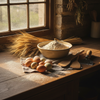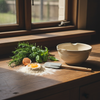Bench Scraper Guide: The Home Chefs Secret Weapon
Key Takeaways
- The bench scraper is a versatile kitchen tool essential for home chefs.
- It is also known as a bench knife or dough cutter.
- The bench scraper excels at cutting, scooping, cleaning, and transferring ingredients.
- This tool helps turn kitchen chaos into culinary confidence.
- Its flat blade allows for precise and efficient food preparation tasks.
Table of Contents
- Bench Scraper 101, What It Is and Why Every Home Chef Needs One
- Anatomy of a Bench Scraper, Materials and Design Details That Matter
- How Bench Scrapers Compare to Other Kitchen Tools
- Bench Scraper Showdown, How It Compares to Other Kitchen Tools
- The Many Uses of a Bench Scraper, From Dough to Décor and Beyond
- Buying the Right Bench Scraper, What to Look for
- Bench Scraper Care, Troubleshooting & Storage Solutions
The Home Chef's Secret Weapon: Mastering the Bench Scraper
Picture this: flour-dusted counters, dough ready to transform into something magical, and you, the home chef, orchestrating it all. Enter the bench scraper, the unsung hero that turns kitchen chaos into culinary confidence. This flat-bladed wonder (also called a bench knife or dough cutter) does what other tools can't, cuts, scoops, cleans, and transfers with surgical precision.
For DI ORO chefs who cook with heart and demand tools that perform, the bench scraper represents everything we stand for: versatility meets health-first design, wrapped in pro-grade materials that never compromise your food's safety. Whether you're portioning sourdough or smoothing buttercream, this tool transforms ambitious recipes from daunting to doable.
If you love versatile kitchen tools, you'll appreciate how a well-designed kitchen utensil can elevate your cooking experience. For those who want to complement their bench scraper, consider the 3-piece seamless spatula set, perfect for mixing, folding, and scraping every last bit from your bowls.
Bench Scraper 101, What It Is and Why Every Home Chef Needs One
The bench scraper earned its stripes in professional bakeries, where speed and precision determine success. This deceptively simple tool, typically measuring 6" x 3" with a straight cutting edge, outperforms specialized gadgets through pure versatility. Unlike knives that nick and spatulas that bend, a quality bench scraper delivers consistent results whether you're dividing pizza dough or decluttering your workspace.
What sets exceptional bench scrapers apart is material integrity. DI ORO's pro-grade, forever-chemical-free silicone withstands temperatures up to 600°F while protecting both your food and nonstick surfaces. This isn't just about performance, it's about peace of mind. When America's Test Kitchen evaluates kitchen tools, they prioritize the same standards we do: durability, safety, and real-world functionality.
The bench scraper transforms three kitchen frustrations into effortless wins: messy ingredient transfers become swift scoops, sticky dough cutting becomes precise portioning, and counter cleanup becomes a single satisfying sweep. For home chefs who refuse to settle, it's the difference between cooking with confidence and cooking with compromise.
Anatomy of a Bench Scraper, Materials and Design Details That Matter

Material choice determines whether your bench scraper becomes a trusted kitchen companion or a drawer disappointment. Stainless steel blades deliver unmatched durability and razor-sharp precision for clean dough cuts, while silicone options protect delicate nonstick surfaces and resist heat up to professional standards. The sweet spot? Hybrid designs that combine stainless steel cores with silicone edges, offering strength where you need it, flexibility where it counts.
| Material | Best For | Temperature Rating | Nonstick Safe |
|---|---|---|---|
| Stainless Steel | Precision cutting, durability | Oven-safe | No |
| Pro-Grade Silicone | Heat resistance, surface protection | 600°F (DI ORO standard) | Yes |
| Hybrid Design | Maximum versatility | 600°F | Yes |
Edge design impacts every task. Squared edges create clean, professional cuts through dough, while slightly rounded edges glide smoothly across bowls and surfaces. Handle comfort matters more than most realize, ergonomic grips reduce hand fatigue during extended baking sessions, while measurement markings eliminate guesswork when portioning. DI ORO's approach integrates these details seamlessly, ensuring each tool performs like an extension of your culinary instincts.
How Bench Scrapers Compare to Other Kitchen Tools
Bench Scraper vs. Bowl Scraper
While bowl scrapers flex to follow curved surfaces, bench scrapers provide rigid precision for flat work. Think of them as complementary tools: bowl scrapers excel at extracting every drop of batter, while bench scrapers master counter-based tasks like dough cutting and ingredient transfer. Serious home chefs keep both within arm's reach.
Bench Scraper vs. Chef's Knife for Ingredient Transfer
A chef's knife's narrow blade makes ingredient transfer precarious and time-consuming. The bench scraper's wide surface area scoops chopped vegetables, herbs, or nuts in a single motion, no balancing act required. Plus, you eliminate the safety risk of using a sharp blade for non-cutting tasks, while protecting your knife's edge from unnecessary counter contact.
Bench Scraper vs. Traditional Spatula
Traditional spatulas bend under pressure and lack the straight edge necessary for clean cuts. Bench scrapers maintain their shape under stress, delivering consistent results whether you're smoothing frosting or portioning sticky caramel. For nonstick cookware, silicone bench scrapers provide the surface protection spatulas promise.
For more insights on spatulas and their role in the kitchen, check out our comprehensive spatula guide for home cooks.
Bench Scraper Showdown, How It Compares to Other Kitchen Tools
The bench scraper sits in a league of its own, but understanding how it stacks against similar tools helps you build the perfect arsenal. Each tool serves distinct purposes, and knowing when to reach for what transforms kitchen chaos into culinary confidence.
Bench Scraper vs. Bowl Scraper
While both scrape, their personalities couldn't be more different. Bowl scrapers flex and bend, hugging curved surfaces to capture every drop of batter from mixing bowls and saucepans. Bench scrapers stand firm, delivering straight cuts through dough and swift counter cleanup. The bowl scraper's silicone flexibility makes it the champion of curved surfaces, while the bench scraper's rigid edge excels at portioning and transferring ingredients.
Most serious home chefs keep both, the bowl scraper for batter rescue missions, the bench scraper for dough mastery and ingredient transport. Think of them as dance partners: one fluid, one precise, both essential for different kitchen choreography.
Bench Scraper vs. Chef's Knife for Ingredient Transfer
Your chef's knife cuts beautifully, but using its blade to scoop chopped vegetables dulls the edge and creates safety hazards. The bench scraper's wide, flat surface scoops ingredients in one smooth motion, protecting both your knife's sharpness and your fingertips. Where a knife blade might scatter herbs or onions, the bench scraper's generous width corrals everything efficiently.
| Feature | Bench Scraper | Chef's Knife |
|---|---|---|
| Scooping Capacity | Wide blade captures more ingredients | Narrow blade, multiple trips needed |
| Edge Protection | Designed for scraping and scooping | Dulls cutting edge over time |
| Safety | Blunt edge, minimal injury risk | Sharp blade requires careful handling |
| Counter Cleaning | Excellent for sweeping debris | Not designed for surface cleaning |
Bench Scraper vs. Spatula & Pan Scraper
Spatulas flip and fold with finesse, while pan scrapers tackle stuck-on bits with curved precision. The bench scraper bridges both worlds, its flat edge lifts delicate cookies like a spatula, yet provides the firm pressure needed for stubborn dough cleanup. For nonstick surfaces, silicone bench scrapers offer the same surface protection as your favorite spatulas, but with superior ingredient-gathering power.
The bench scraper's rectangular shape maximizes surface contact, making it more efficient than round spatulas for large-batch ingredient transfer. When you're moving mountains of chopped vegetables or portioning cookie dough, that extra width saves time and reduces mess.
The Many Uses of a Bench Scraper, From Dough to Décor and Beyond

The bench scraper transforms from humble tool to kitchen superhero once you discover its full potential. Beyond basic dough cutting, this versatile blade tackles tasks you never imagined, streamlining your workflow and elevating your results.
Portioning and Cutting Dough Like a Pro
Perfect dough portions start with proper technique. Flour your bench scraper lightly, then position it perpendicular to your work surface. Press straight down through the dough, no sawing motions that can tear delicate gluten networks. For pizza dough, divide into equal portions by weighing, then use swift, confident cuts. Between cuts, wipe the blade clean to prevent sticking and ensure razor-sharp edges on your finished pieces.
Professional bakers rely on this method because it preserves dough structure while creating uniform portions that bake evenly. The key lies in decisive movements, hesitation leads to ragged edges and compromised texture.
Transferring Chopped Ingredients with Less Mess
Transform your prep game by using the bench scraper's full width advantage. After chopping, slide the scraper under ingredients with a gentle rocking motion, then lift and transport in one fluid movement. This technique prevents the scattered-ingredient chaos that occurs when using knife blades or narrow spatulas.
For cross-contamination prevention, especially with raw proteins, the bench scraper becomes essential. Its easy-clean surface and dishwasher compatibility make it safer than wooden tools, while pro-grade silicone options eliminate forever-chemical concerns entirely.
Cleaning & Decluttering Your Work Surface
The bench scraper excels at the "clean as you go" philosophy that separates confident cooks from chaotic ones. Every five minutes during prep, sweep flour, herb bits, and sticky residue toward your compost bowl or trash. The flat edge captures debris that sponges and towels leave behind, preventing bacterial buildup and cross-contamination.
For sticky situations like caramel or honey spills, the scraper's firm edge removes residue without spreading it further, a trick that saves both time and sanity during intensive baking sessions.
Baking & Cake Decorating Hacks
Professional-level cake decorating becomes accessible with the right bench scraper technique. For buttercream smoothing, hold the scraper at a 45-degree angle against your cake while rotating the turntable in one continuous motion. Dip the blade in warm water between passes to prevent drag marks and achieve that coveted mirror-smooth finish.
Precision baking benefits from the scraper's leveling abilities, use the flat edge to level flour in measuring cups, ensuring accurate measurements for recipes that demand exactness. The straight edge also creates clean lines when cutting brownies or bar cookies, elevating presentation from homemade to bakery-worthy.
Creative Applications Beyond the Basics
The bench scraper's versatility extends far beyond traditional baking. Use it to chop chocolate into uniform pieces, divide sticky caramel into portions, or even shape gnocchi ridges. When making fudge or candy, the scraper's clean edge creates perfect squares without the dragging that occurs with knives.
For Asian cuisine enthusiasts, the bench scraper excels at portioning sticky rice and transferring delicate dumplings without tearing. Its flat surface also works brilliantly for creating lattice pie crusts, providing the support needed to lift and weave pastry strips with precision.
For more creative kitchen inspiration, explore our rubber scraper blog for tips and techniques that go beyond the basics.
Buying the Right Bench Scraper, What to Look for
Selecting the perfect bench scraper requires understanding how material choices, design features, and construction quality impact your daily cooking experience. The right tool becomes an extension of your hands, while the wrong choice creates frustration and limits your culinary potential.
Material Matters for Health and Performance
Pro-grade silicone and high-quality stainless steel outperform cheaper alternatives in durability, safety, and versatility. Forever-chemical-free materials protect your family's health while maintaining peak performance through thousands of uses.
Essential Selection Criteria
Material composition drives both performance and safety. Stainless steel offers unmatched durability and precision cutting, while pro-grade silicone provides nonstick compatibility and heat resistance up to 600°F. Hybrid designs combine steel cores with silicone edges, delivering strength with surface protection. Avoid mystery plastics or tools without clear material certifications, your food safety depends on knowing exactly what touches your ingredients.
Surface compatibility determines versatility. If you cook with nonstick pans or delicate surfaces, silicone or plastic edges prevent scratching. For heavy-duty dough work and precise cutting, stainless steel delivers superior results. The ideal kitchen arsenal includes both options for different tasks.
Ergonomic design impacts comfort during extended use. Look for handles at least 4 inches wide for secure grip, with textured surfaces that won't slip when wet. Built-in measurement guides transform your scraper into a precision tool, eliminating guesswork in portioning and spacing.
Performance-Tested Recommendations
| Brand/Model | Material | Blade Width | Special Features | Best For |
|---|---|---|---|---|
| OXO Good Grips | Stainless steel | 6 inches | Measurement markings, ergonomic handle | All-purpose baking and prep |
| DI ORO Seamless Series | Pro-grade silicone | 5.5 inches | Forever-chemical free, 600°F heat resistant | Health-conscious cooks, nonstick surfaces |
| Norpro Grip-EZ | Stainless steel | 6 inches | Santoprene handle, dishwasher safe | Heavy-duty dough work |
| King Arthur Baking | Stainless steel | 6 inches | Professional weight, ruler markings | Serious bread bakers |
Scenario-Based Selection
For the health-conscious cook: Choose forever-chemical-free silicone options that eliminate toxic exposure while delivering professional performance. DI ORO's pro-grade materials meet the highest safety standards without compromising functionality.
For nonstick cookware users: Silicone or hybrid scrapers protect delicate surfaces while providing the rigidity needed for effective dough work. Look for heat ratings above 400°F to handle hot surfaces safely. If you need a full set of nonstick-safe tools, the silicone spatula set is a smart addition to your kitchen.
For bread and pastry enthusiasts: Stainless steel delivers the precision cuts and durability required for serious baking. Built-in measurements eliminate guesswork in portioning, while the rigid edge creates clean, professional results. For those who bake often, the baking collection offers a range of specialty tools to support your craft.
Bench Scraper Care, Troubleshooting & Storage Solutions
Proper maintenance extends your bench scraper's lifespan while ensuring food safety and optimal performance. Understanding common issues and their solutions prevents frustration and protects your investment in quality tools.
Common Problems and Professional Solutions
To learn more about the history and uses of kitchen scrapers, visit the Wikipedia page on kitchen scrapers for an authoritative overview.
For award-winning kitchen utensils that complement your bench scraper, explore our award winning kitchen utensils collection for top-rated tools trusted by chefs.
For further reading on kitchen trends and tips, browse our news blog for the latest updates and inspiration.
If you're interested in a large, pro-grade spatula for big baking projects, check out the Seamless Pro 14-Inch Large Silicone Spatula for unmatched versatility.
For more on specialty kitchen tools, see our specialty tools for unique solutions to everyday cooking challenges.
For additional background on bench scrapers and their role in culinary history, you may also find this external resource helpful.
Frequently Asked Questions
What are the main uses of a bench scraper in home cooking?
A bench scraper is perfect for cutting dough, scooping chopped ingredients, cleaning flour-dusted counters, and transferring food with precision. It helps home chefs keep their workspace tidy while tackling tasks from dividing pizza dough to smoothing buttercream.
How do different bench scraper materials affect their performance and safety?
Materials impact durability, heat resistance, and food safety. DI ORO’s pro-grade, forever-chemical-free silicone withstands high temperatures up to 600°F and protects nonstick surfaces, ensuring both performance and peace of mind in the kitchen.
Why is a bench scraper considered more versatile compared to other kitchen tools like knives or spatulas?
Unlike knives that can nick surfaces or spatulas that bend, a bench scraper’s rigid, flat blade cuts, scoops, cleans, and transfers with surgical precision. This multi-functionality makes it a go-to tool for a wide range of prep tasks, turning kitchen chaos into culinary confidence.
What should I look for when buying a high-quality bench scraper?
Look for a bench scraper with a sturdy, flat blade made from durable, food-safe materials like pro-grade silicone or stainless steel. It should be easy to clean, heat-resistant, and designed to protect your cookware while offering precise control for cutting and transferring ingredients.




